MESA VERDE (Day 16 - part 1)
On our way back to Capitol Reef, we passed a small group of bison.

Bison are native to southern Utah and this area. At one time, as many as 50 million animals roamed North America. By the late 1800's, they had been hunted to near extinction, except for the Yellowstone Park herd. Bison from that herd were reintroduced back into this area in the 1940's, settling mostly in the grasslands near the Henry Mountains (only about 25 miles from here). Although the mountain is capable of supporting up to 400 bison, the state tries to keep the population around 325. As a result, this is the only huntable free-roaming herd in the US.

The bison shed their shaggy winter coats during summer.

They can weigh up to a ton, run 35 miles per hour, and travel 20 miles a day.
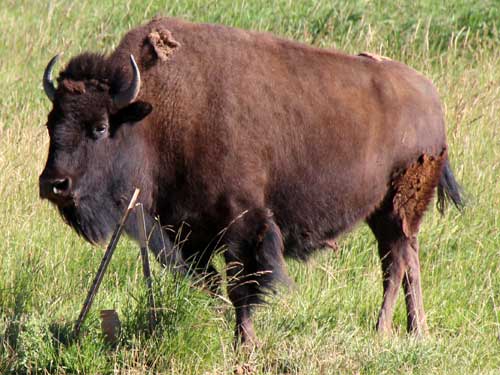
A beautiful pose!
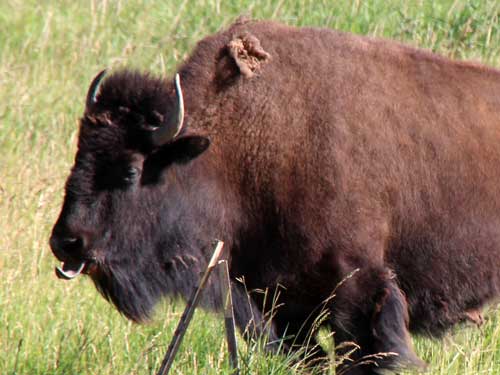
Aaaand there he goes, making fun of us. I wonder if he's friends with those darn Bryce Canyon deer?!
We entered Capitol Reef and swung by the orchard to grab a few more apricots. We weren't the only ones there for a feast... many deer roamed under the trees, eating as much as they could. The marmots were also awake, having a breakfast of grasses in the fields.
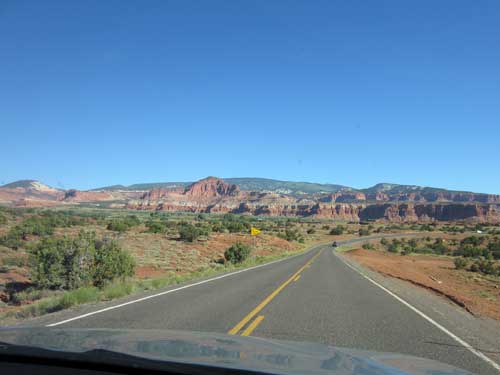

So good!!

Raiding the fallen fruit


Mule deer are found throughout western North America, where they range from open deserts to high mountains. They also don't shy away from urban areas. They primarily eat shrubs and other woody material as well as grasses.


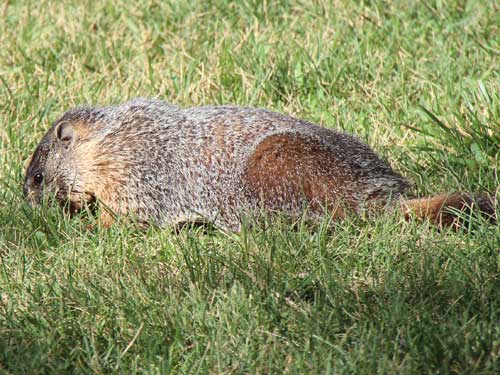
There are 15 species of marmots, which are basically just large squirrels. This is a Yellow-bellied Marmot. It is found in the western US and abundant in this area. It is only active a few months during the summer, then it disappears into hibernation for the rest of the year.
A groundhog or woodchuck is another species of marmot found back East. Marmots such as the Yellow-bellied live in mountainous areas whereas the groundhog sticks to the lowlands.

We had read that the schoolhouse was going to be open this morning, so we hurried over to take a look inside. Unfortunately it was closed. We swung back by the visitor center to ask about it. Apparently, yes, the schoolhouse is open during this time when a ranger is available... and no ranger is available. But at least the sunlight was a bit better so we could actually see inside.
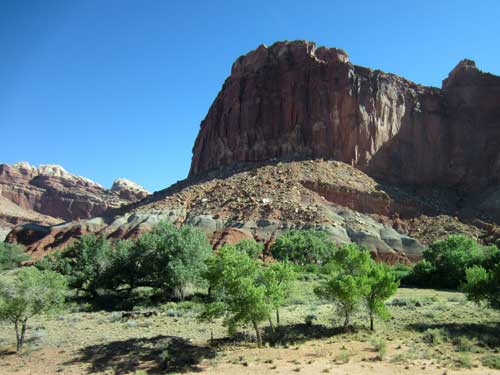

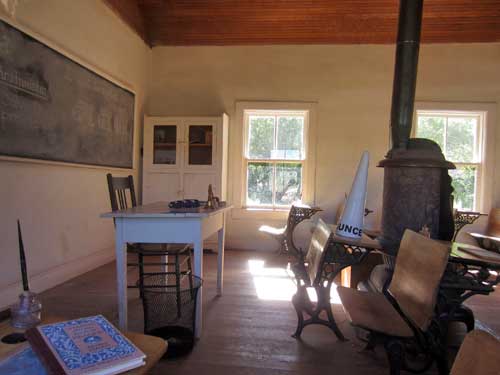
Typical furnishings of the time... a blackboard, a furnace, desks, a dunce cap...
Today, the dunce cap is the symbol of stupidity and shame. Children who misbehaved or failed their lessons were made to wear it as they stood in the corner. The word 'dunce' comes from Duns Scotus, a Franciscan friar, philosopher, theologian and professor at Oxford, Cambridge and Paris in the late 1200's. He was a very brilliant man in his time. His followers were known as Dunsmen or Dunces. Duns believed that wearing conical hats increased learning, that they could funnel knowledge to the crown of the head. Besides, powerful wizards and witches also wore them. The hat became a symbol of knowledge... until Duns' teaching fell drastically out of favor around the 16th century and the hat became identified with ignorance rather than learning.

Johannes Duns Scotus (circa 1266 - 1308) with his tall hat
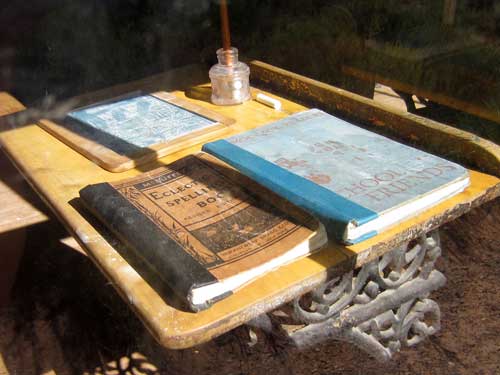
We grabbed another pie (cherry, this time) from the Gifford House then left the park via the east side, catching a few more interesting sights as we went.

We passed by the park's namesake, the line of white Navajo Sandstone domes similar to the ones often placed on capitol buildings.


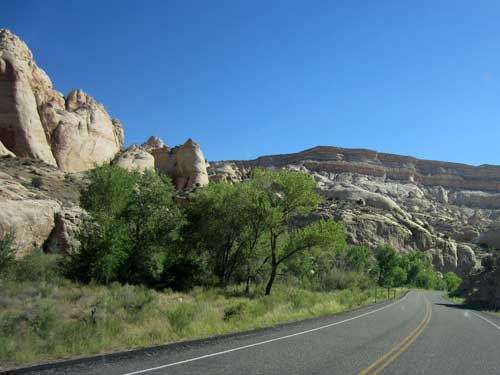
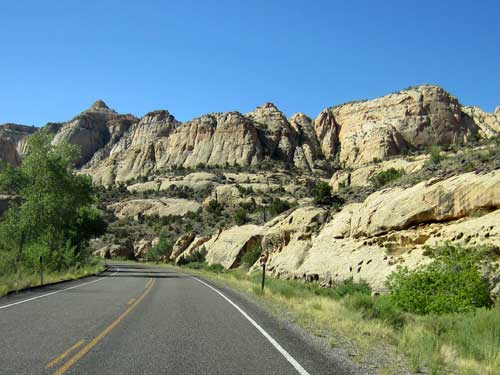
We made a quick stop at the Behunin cabin.
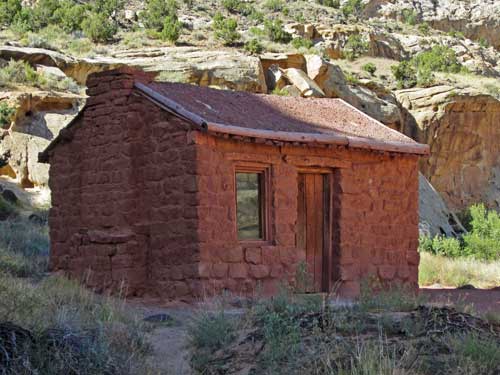
The desire for religious freedom and to create new self-sufficient communities led many Mormon settlers to this remote area. This one-room cabin was built in 1882 by Elijah Cutler Behunin and his family. But life was extremely rough out here. Flash floods often covered the wagon roads with boulders and debris. Dams and ditches were in constant need of repair. Isolation and rigorous work allowed little opportunity for socializing with other settlers. The Behunins moved up-canyon to the higher grounds of Fruita within a year.

Elijah and his wife Tabitha Jane, together with 11 of their 13 children in 1896

The flooding of the Fremont River
We left the park and continued to follow Highway 24 west to Hanksville where we turned south on Highway 95. This led us through the Glen Canyon National Recreation Area and over the Colorado River.






Remnants of the past


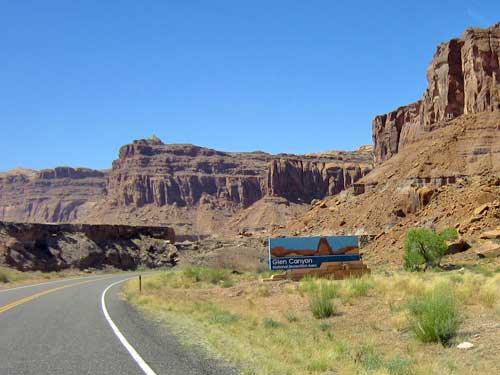
Entering the Glen Canyon National Recreation Area

Skirting the edges of Lake Powell

We stopped briefly at Hite Overlook.

Lake Powell

Back in 1869 when John Wesley Powell first rafted through this area, it was Glen Canyon, home of the turbulent, yet-unexplored Colorado River. Today it is part of Lake Powell, which was created in 1963 by the Glen Canyon Dam.

John Wesley Powell (1834 - 1902) actually did all this rafting and exploring with only one arm!
During the Civil War, he lost most of his right arm when struck by a Minie ball (a conical-shaped, muzzle-loaded rifle bullet that was designed to cause more damage than the standard round-ball bullets. Round balls often got lodged in the flesh and could be diverted by muscle and bone from more vital organs. With a higher muzzle velocity and greater weight, the Mini ball tended to cut a straight path. If it struck a bone, it usually caused the bone to shatter and the damage was often severe enough to necessitate amputation).

Far off in the distance...
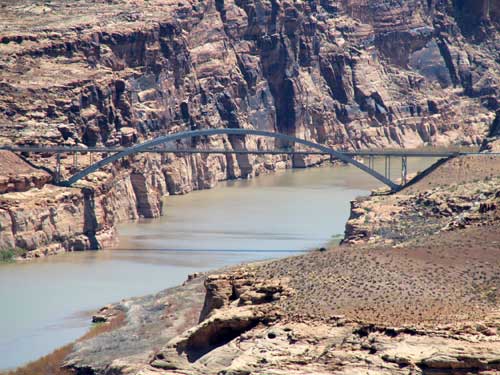
... is this bridge we would soon cross.

Cass Hite (1845 - 1914)
In 1883, Navajo Chief Hoskininni led Cass Hite to the canyon below us where he found gold. Hite built a small store and post office to supply incoming miners. After WWII, the town's population was over 200. Eventually the mining boom ended, and in 1964, the rising waters of Lake Powell swallowed up the town forever.

Hite City's watery grave
return • continue

